Millimeter-Wave 3D-Printed Antenna Concepts for 5G Backhaul Links
Nour Nachabe, Aimeric Bisognin, Diane Titz, Cyril Luxey, Polytech’lab, Université Nice Sophia-Antipolis
Frédéric Gianesello, STMicroelectronics
Sérgio A. Matos, Jorge R. Da Costa, Instituto de Telecomunicações, Instituto Universitário de Lisboa
Carlos A. Fernandes, Instituto de Telecomunicações, Instituto Superior Técnico, Universidade de Lisboa
Carlos del Río Bocio, Universidad Pública de Navarra
Mahmoud Sawaby, Amin Arbabian, Stanford University
This email address is being protected from spambots. You need JavaScript enabled to view it.
IEEE Future Networks Tech Focus: Volume 3, Number 1, March 2019
Abstract
Increasing the area traffic capacity of the mobile network by adding small cells and re-organizing the radio access network is one of the most important milestones of the 5G deployment. The dense deployment of small cells, however, will put a tremendous burden on the backhaul intermediate links. To respond to this challenge, millimeter wave (mmW) wireless backhaul links are gaining prominence because of their ease of deployment and the large bandwidth they could offer to assure multi-Gb/s links. To achieve those requirements, leveraging 3D printing technologies to develop low-cost compact antennas for the mmW radios is rising as a promising solution.
1. Introduction
Facing the ever-increasing number of wireless devices that are accessing mobile networks worldwide, the global mobile traffic is growing exponentially [1]. For instance, to keep-up with the associated increasing data traffic, the speed of the mobile network connections grew more than 3-fold from 2015 to 2016 [2] reaching an average downstream speed of 7.2 Mb/s in 2017 [3]. However, these data rates are still insufficient to keep-up with the emerging highly data-consuming applications like Augmented reality, virtual reality and ultra-high definition videos (4K, 8K) scheduled to boom-up in the future years.
Evolving today’s networks to 5G standard is key to keeping pace with the future demands for connectivity. 5G key goals aim to achieve multi-Gb/s links for enhanced mobile broadband along with ultra-reliable and low latency communication services. To reach those targets, a drastic increase in the area traffic capacity is needed (from 0.1Mb/s/m2 targeted for 4G to 10 Mb/s/m2 targeted for 5G), leading to the deployment of ultra-dense high-capacity small cells-based networks.
Densifying the existing networks pushes to rethink its architecture and radio technology to enable an easy and inexpensive deployment of the intermediate portion of the network linking the small cells to the core network, named backhaul. In this context, mmW frequencies, especially those above 42 GHz, emerge as the driving force behind high-capacity backhaul links due to the large bandwidth available. Although mmW frequencies provide shorter communication link distance due to higher atmospheric attenuation compared to lower frequencies, this fact is rather considered beneficial for dense deployments as it limits the possible interference between neighbor links. Hence, mmW low-cost and compact radio systems enabling multi-Gb/s backhaul links are considered as a major building block to pave the way toward 5G as it will be explained in the next sections.
2. High-density small cells networks employing C-RAN architecture
Small cells are radio access points covering a cell radius ranging from few meters to few kilometers. They complement the existing macrocells to boost the area traffic capacity of the network. Small cells can comprise outdoor systems but indoor systems as well (Table 1 from [4]) and can use different access technologies giving rise to heterogeneous networks.

In the past decade, small cells deployment was hampered by implementation difficulties such as the optical fiber infrastructure costs. Nowadays, with the development of higher capacity mmW wireless links, they are considered as a viable alternative for fiber optic links enabling large-scale deployments of small cells. Possible small cell densities can hence reach as high as four-to-ten small cells for every existing macrocell [5].
To facilitate the densification of the network, the cellular infrastructure must be flexible and support simplified management of increasingly heterogeneous Radio Access Networks (RANs). By combining virtualization, centralization and coordination techniques, future Cloud-RAN (C-RAN) architecture can achieve those targets while exploiting the already available transport infrastructure [6].
A typical C-RAN architecture is shown in Figure 1 illustrating a fully centralized baseband approach [7]. The baseband resources are pooled at a BaseBand Unit (BBU) and centralized at a virtual BBU pool. Virtual BBU pools further facilitate scalability, cost reduction, integration of different services and reduction in time consumption for field trials as the execution platform can perform the same tasks with less hardware. On the other side of the network, Remote Radio Heads (RRH) handle the analog processing (power amplification, filtering, etc.) on the channel. Hence, the cost and time of deploying RRHs decrease considerably compared to traditional base stations since the installation footprint is much smaller.

Figure 1: C-RAN global architecture.
The challenge of C-RAN deployment lies in the connection between the RRHs and the BBU pool featuring high-speed (data rates higher than 1 Gb/s), low-latency, and accurately synchronized network, the so-called “fronthaul” via Common Public Radio Interface (CPRI) links. However, the potential gains in the baseband centralization may in practice be limited by the cost of the CPRI, which is the main challenge to be addressed in this context [8]. The cost of deployment, the flexibility and the scalability naturally give the advantage to wireless links over optical fibers for backhaul/fronthaul deployment. By exploiting mmW frequencies, the performance of the wireless links like data rates and capacity can approach those of fiber optic links.
3. 5G millimeter wave spectrum
The wireless network capacity is governed by spectral efficiency and available bandwidth according to Shannon’s theorem, but it is also related to the size of the cell. As networks with small cells are being increasingly employed, the physical layer technology has however reached its limits. Thus, exploring new bandwidths is an utmost necessity. To deliver higher capacity with those wireless links, lower frequency technologies rely on complex radio-frequency techniques like multi-path propagation and channel aggregation below 6 GHz or spatial multiplexing at higher frequencies up to 42 GHz. In contrast, mmW technologies operating beyond 42 GHz rely on the availability of wideband frequency channels to deliver multi-Gbps of throughput, using simple single-channel modulation schemes. This simplicity in terms of design gives those mmW spectrums the advantage of offering the best cost-per-bit option for high-capacity backhaul links.
More specifically, the 57-66 GHz V-band offers 9 GHz of unlicensed spectrum available worldwide. The interest in V-band is especially due to its propagation characteristics featuring high free-space loss accentuated by the oxygen absorption. This implies an exceptional immunity to interference and enhances the frequency re-use in the neighbor small cells which ideally suits the evolution of backhaul towards high-capacity short-range links. Due to those losses, V-band is mainly used street level connections as line-of-sight links (Figure 2). To compensate for the high atmospheric attenuation in V-band, high-gain (> 30 dBi) narrow beamwidth (3° half-power beamwidth) antennas are employed to extend the practical reach of the system to several kilometers.
It should be noticed that the short 5 mm wavelength at V-band allows to design high-gain antennas with a small form factor of about 10 cm2. Radio system with small size is one of the key requirements for the small cell environment, especially for street level installations where aesthetic concerns arise. Lastly, the adoption of V-band radio systems is further empowered by the maturity of silicon technologies at 60 GHz and many commercialized V-band transceivers using SiGe technology have established data rates up to 1 Gb/s over a link distance up to 1 km using 64 QAM modulation [9].
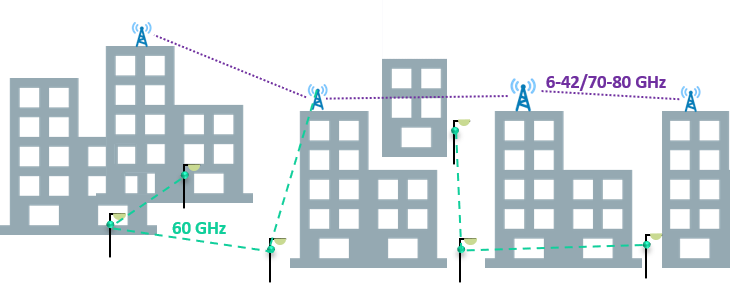
Figure 2: mmW backhaul and fronthaul links scenario.
In order to simplify the modulation scheme and achieve data rates higher than 1Gbp/s, higher frequencies are also being investigated. Referring to the FCC frequency allocation table, wide bandwidths are allocated for the mobile and fixed applications between 100 and 200 GHz [10]. As an example, around 120 GHz, 26 and 18 GHz are respectively allocated for mobile and fixed applications. Successful attempts have been demonstrated between 116.5-133.5 GHz, achieving 10 Gb/s data rate with Amplitude Shift Keying (ASK) modulation over a 1 km range using a III-V transceiver [11]. However, the potentiality of silicon technologies for transceivers operating at 100-140 GHz range have been also demonstrated by several research works [12] [13], opening-up the way for the design of systems with much lower-cost. However, to achieve a completely integrated radio system operating at those mmW frequencies, cost, size and integrability of the antenna are the main determining factors.
4. High-gain 3D-printed lens antennas
Among high-gain antennas, lenses are simple-to-manufacture designs compared to planar arrays. They are also less bulky in size compared to reflector antennas. Dielectric lenses are commonly used to collimate the radiation of a source. When the source is placed at the focal point of the lens, all rays emerging from the surface of the lens are theoretically parallel to the axis of the lens considerably increasing the directivity of the source. Many V-band lenses for backhaul applications are commercially available, however, at an expensive price due to the used material like Rexolite or High-Density PolyEthylene (HDPE) but also due to the use of their micromachined sources (mainly horns) [14] [15]. In contrast, 3D-printing techniques using commonly available low-cost material like ABS-M30 are a promising approach due to the acceptable accuracy they can provide (typically +/-200 µm). By exploiting 3D-printing advantages enabling fast and easy prototyping, we already designed and measured several elliptical lens antennas [16]. However, ABS-M30 is characterized by relatively higher dielectric losses compared to HDPE or Rexolite which is a limiting factor for high gain antennas. A simple design trick consists in using a dome-type elliptical lens with an inside air-cavity to limit the height of the dielectric. An example is shown in Figure 3 featuring the realization of a V-band lens 3D-printed by Fused Deposition Modeling (FDM) technique using ABS-M30 filaments. The source of the lens is a corrugated horn realized by Stereolithography Apparatus (SLA) and metallized by a metal-plating process optimized by Swissto12 [17]. The designed lens and the horn-source occupying a total volume of 10×10× 13.3 cm3 achieved a 31 dBi measured gain from 57 to 66 GHz.
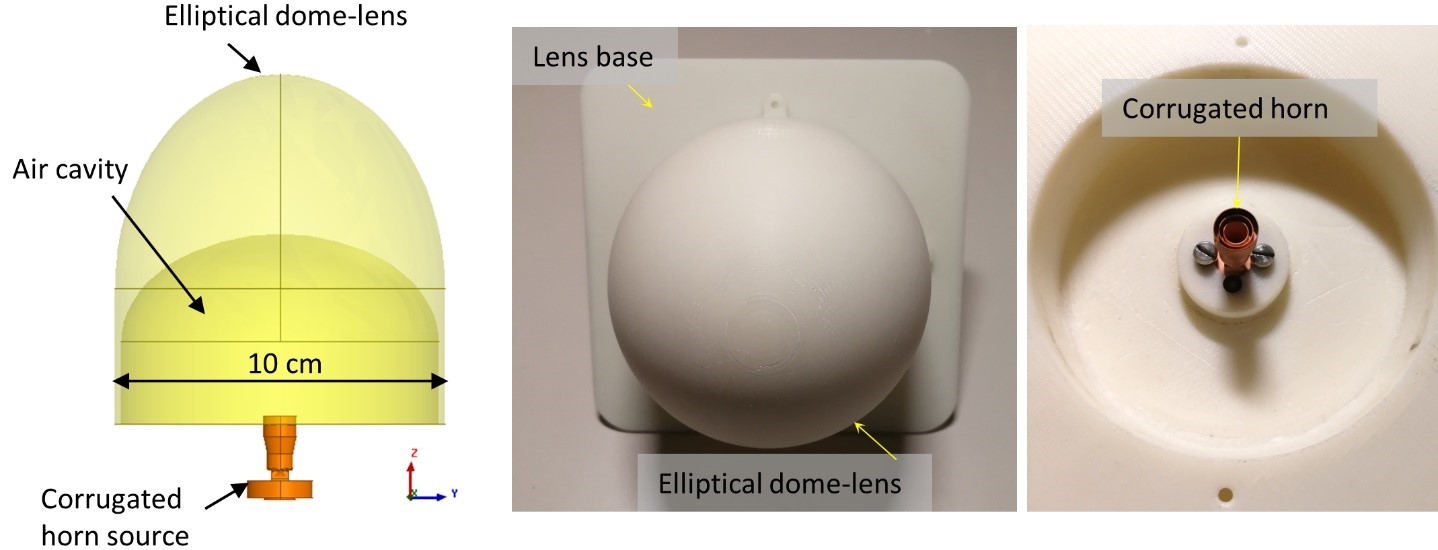 (a) (b)
(a) (b)
Figure 3: (a) Side view of the simulation model of a V-band elliptical lens with corrugated horn source. (b) Picture of the V-band 3D-printed lens and horn source held by a custom base.
This lens concept has been scaled in the F-band. Figure 4 features the F-band lens system operating from 110 to 140 GHz. In this antenna-system, the horn source was replaced by a Ball Grid Array (BGA) module with an integrated 2×2 array of patch antennas source which is more suitable for mass production and much cheaper than a 3D-printed horn. The BGA package employing a High-Density Interconnect (HDI) technology with organic substrate build-up also serves as a package for a flip-chipped-mounted transceiver enabling a fully integrated communicating system. The BGA and the associated 4 cm diameter 3D-printed lens achieved a measured gain of 28 dBi. To validate the full system, a specially designed transceiver employing an energy-efficient On-Off Keying (OOK) modulation scheme was flip chipped over the other side of the BGA package. This Tx/Rx system achieved data rates above 12 Gbps with less than 10-6 Bit Error Rate at nearly 5 m distance [18].
These demonstrations validate the possibility of using low-cost mmW antenna-systems fabricated with 3D printing technologies. Achieved performances are very promising and open-up the way for compact mmW radio systems easily accommodated for mass-production due to the use of industrial process and ready to be deployed in practical scenarios.
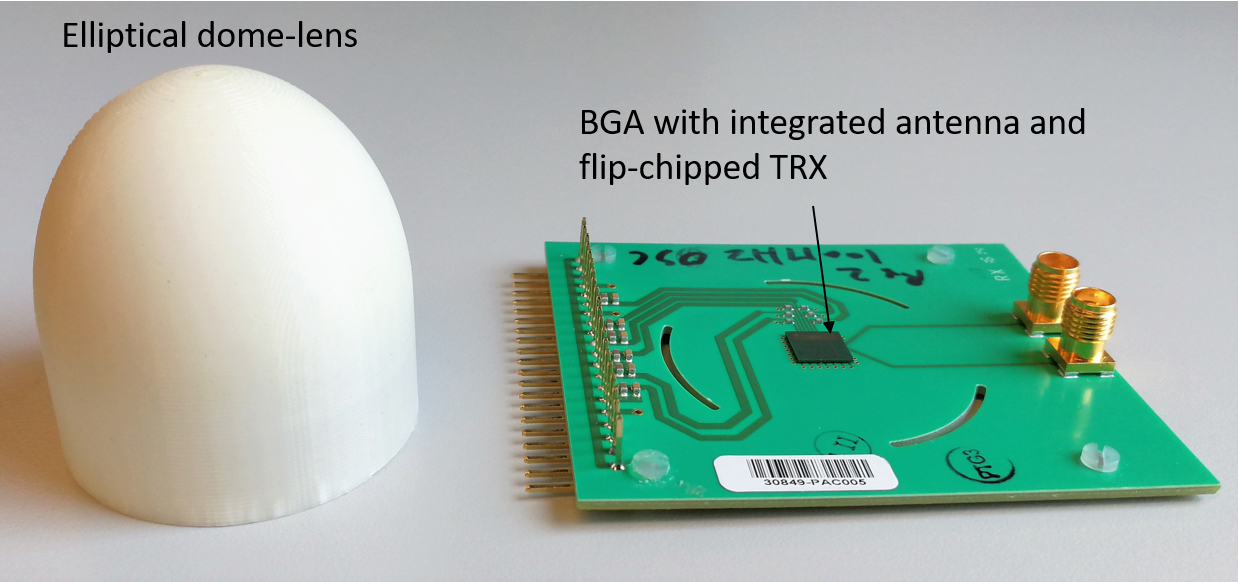
Figure 4: F-band antenna-system composed by an ABS lens and an integrated BGA source.
5. Conclusion
The evolution towards 5G to respond to future connectivity demands is driven by the densification of the existing mobile network. To cope with this network densification, new architectures are proposed allowing scalable and easy-to-deploy infrastructures which gives rise to C-RAN concept. C-RAN consists in splitting the physical layer (located at the RRHs) from the upper network layers and centralizing the baseband resources in a common BBU pool. The main challenge is to achieve high capacity links with low-cost deployments to connect the RRH to the BBU pool also called backhaul/fronthaul links. Generous bandwidths available at V and F bands make this spectrum the best candidate for the establishment of those links. V-band radio systems already demonstrated data rates higher than 1 Gbps over distances ranging between 200 m and 1 km, however their cost remains a limiting factor. Furthermore, research is undergoing to further accelerate the data rates towards 10 Gb/s using the 120 GHz band. The cost-effectiveness of those mmW radio systems mainly depending on the antenna-system and integration remains the main determining factor for pushing forward the adoption of mmW backhaul links in a massive way. Leveraging the high-potential of 3D-printing technologies, fast and cheap manufacturing can be accessed to develop high gain lens-antenna systems. 3D-printing methods like FDM and SLA along with organic substrate HDI packages have been proven reliable for the realization of compact quasi-optical antenna systems satisfying backhaul links mass-market specifications in terms of performance and cost deployment.
References
- “Cisco Visual Networking Index: Global Mobile Data Traffic Forecast Update, 2015–2020 White Paper,” Cisco. [Online]. Available: http://www.cisco.com/c/en/us/solutions/collateral/service-provider/visual-networking-index-vni/mobile-white-paper-c11-520862.html. [Accessed: 27-May-2016].
- “Future mobile data usage and traffic growth – Ericsson,” Ericsson.com, 11-Aug-2016. [Online]. Available: https://www.ericsson.com/en/mobility-report/future-mobile-data-usage-and-traffic-growth. [Accessed: 04-Aug-2018].
- “Global Average Connection Speed Increases 15 Percent Year over Year, According to Akamai’s ‘First Quarter, 2017 State of the Internet Report’ | Akamai.” [Online]. Available: https://www.akamai.com/uk/en/about/news/press/2017-press/akamai-releases-first-quarter-2017-state-of-the-internet-connectivity-report.jsp. [Accessed: 06-Aug-2018].
- “Small Cell Networks and the Evolution of 5G - Qorvo.” [Online]. Available: https://www.qorvo.com/design-hub/blog/small-cell-networks-and-the-evolution-of-5g. [Accessed: 07-Oct-2018].
- Agiwal, A. Roy and N. Saxena, "Next Generation 5G Wireless Networks: A Comprehensive Survey," IEEE Communications Surveys & Tutorials, vol. 18, no. 3, pp. 1617-1655, thirdquarter 2016.
- Perrin, “Evolving to an Open C-RAN Architecture for 5G,” White Paper, Sept 2017. [Online]. Available: https://www.fujitsu.com/us/Images/FNC-Fujitsu-Evolving-to-an-Open-C-RAN-Architecture-for-5G-White-Paper.pdf. [Accessed: 26-Oct-2018].
- Telefonica and Ericsson, “Cloud RAN Architecture for 5G”, White Paper. [Online]. Available: http://www.tid.es/sites/526e527928a32d6a7400007f/content_entry5321ef0928a32d08900000ac/578f4eda1146dde411001d0e/files/WhitePaper_C-RAN_for_5G_-_In_collab_with_Ericsson_SC_-_quotes_-_FINAL.PDF. [Accessed: 26-Oct-2018].
- de la Oliva, J. A. Hernandez, D. Larrabeiti and A. Azcorra, "An overview of the CPRI specification and its application to C-RAN-based LTE scenarios," in IEEE Communications Magazine, vol. 54, no. 2, pp. 152-159, February 2016.
- Infineon, “mmW Backhaul and Fronthaul - Infineon Technologies.” [Online]. Available: https://www.infineon.com/cms/en/product/rf-wireless-control/mmwave-mmic-transceivers-24-86-ghz/mmw-backhaul-and-fronthaul/. [Accessed: 06-Mar-2018].
- FCC, “FCC online table of frequency allocations,” Oct 2018. [Online]. Available: https://transition.fcc.gov/oet/spectrum/table/fcctable.pdf. [Accessed: 16-Oct-2018].
- Hirata, T. Kosugi, H. Takahashi, J. Takeuchi, H. Togo, M. Yaita, N. Kukutsu, K. Aihara, K. Murata, Y. Sato, T. Nagatsuma, Y. Kado, "120-GHz-Band Wireless Link Technologies for Outdoor 10-Gbit/s Data Transmission," IEEE Transactions on Microwave Theory and Techniques, vol. 60, no. 3, pp. 881-895, March 2012.
- Fujimoto, M. Motoyoshi, K. Takano and M. Fujishima, "A 120 GHz / 140 GHz dual-channel ASK receiver using standard 65 nm CMOS technology," 6th European Microwave Integrated Circuit Conference (EuMIC 2011), Manchester, 2011, pp. 628-631.
- Fujishima, M. Motoyoshi, K. Katayama, K. Takano, N. Ono and R. Fujimoto, "98 mW 10 Gbps Wireless Transceiver Chipset With D-Band CMOS Circuits," IEEE Journal of Solid-State Circuits, vol. 48, no. 10, pp. 2273-2284, Oct. 2013.
- SAGE Millimeter inc., “SAGE millimeter, V-band Gaussian optics Antenna,” [Online]. Available: https://www.sagemillimeter.com/36-dbi-gain-58-to-68-ghz-6-diameter-lens-wr-15-waveguide-v-band-gaussian-optics-antenna/. [Accessed: 16-Oct-2018].
- B. Lima, J. R. Costa, J. R. Costa, and C. A. Fernandes, “Mechanical beam-steerable elliptical dome lens,” The 9th European Conference on Antennas and Propagation, EuCAP, March 2009, Berlin.
- Bisognin, D. Titz, C. Luxey, G. Jacquemod, R. Pilard, F. Gianesello, D. Gloria, C. Laporte, H. Ezzedine, J. R. Costa, E. B. Lima, C. A. Fernandes, F. Devillers, “Millimeter-wave antenna-in-package solutions for WiGig and backhaul applications,” International Workshop on Antenna Technology (iWAT 2015), 2015, pp. 52–55, Seoul.
- http://www.swissto12.com/ [Online]. [Accessed: 31-October-2018].
- Bisognin, N. Nachabe, C. Luxey, F. Gianesello, D. Gloria, J. R. Costa, C. A. Frenandes, Y. Alvarez, A. Arboleya-Arboleya, J. Laviada, F. Las-Heras, N. Dolatsha, B. Grave, M. Sawaby, A. Arbabian, "Ball Grid Array Module With Integrated Shaped Lens for 5G Backhaul/Fronthaul Communications in F-Band," in IEEE Transactions on Antennas and Propagation, vol. 65, no. 12, pp. 6380-6394, Dec. 2017.
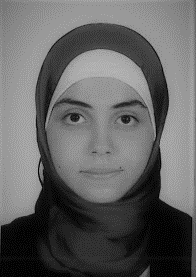 Nour Nachabe received the Bachelor’s degree in electrical and electronics engineering and the Master’s degree in telecommunications from the Lebanese University, Tripoli, Lebanon, in 2015. Since 2015, she has been a Ph.D. student with Université Côte d’Azur, Nice, France, working with Polytech’Lab. Current research interests include design and measurement of millimeter wave antennas, wide band array antennas and additive manufacturing technologies for building RF components in millimeter wave frequency bands.
Nour Nachabe received the Bachelor’s degree in electrical and electronics engineering and the Master’s degree in telecommunications from the Lebanese University, Tripoli, Lebanon, in 2015. Since 2015, she has been a Ph.D. student with Université Côte d’Azur, Nice, France, working with Polytech’Lab. Current research interests include design and measurement of millimeter wave antennas, wide band array antennas and additive manufacturing technologies for building RF components in millimeter wave frequency bands.
 Aimeric Bisognin (S’13) was born in Toulouse, France, in 1989. He received the Engineering degree in electronics from Polytech’Nice Sophia, Sophia Antipolis, France, in 2012, and the M.S. degree in telecommunications from EDSTIC, Sophia Antipolis, France, in 2012, and the Ph.D. degree in electronics engineering (with Hons.) from the University of Nice Sophia-Antipolis, France, in 2015. During his Ph.D., he worked with the Polytech’Lab, STMicroelectronics, Crolles, France. He has authored or coauthored more than 10 publications in journals and 20 publications in international conferences. His research interests include millimeter-wave communications, especially in the field of the design and measurement of antenna in package, lens and reflector antennas for the 60, 80, and 120 GHz frequency bands.
Aimeric Bisognin (S’13) was born in Toulouse, France, in 1989. He received the Engineering degree in electronics from Polytech’Nice Sophia, Sophia Antipolis, France, in 2012, and the M.S. degree in telecommunications from EDSTIC, Sophia Antipolis, France, in 2012, and the Ph.D. degree in electronics engineering (with Hons.) from the University of Nice Sophia-Antipolis, France, in 2015. During his Ph.D., he worked with the Polytech’Lab, STMicroelectronics, Crolles, France. He has authored or coauthored more than 10 publications in journals and 20 publications in international conferences. His research interests include millimeter-wave communications, especially in the field of the design and measurement of antenna in package, lens and reflector antennas for the 60, 80, and 120 GHz frequency bands.
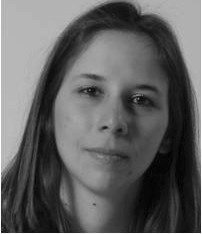 Diane Titz (S’11–M’12) received the M.S. (Hons.) degree in telecommunications from the University of Paris-Sud (XI), and the École Normale Supérieure de Cachan, Paris, France, and the Ph.D. (Hons.) degree in electrical engineering from the University of Nice Sophia Antipolis, Nice, France, in 2009 and 2012, respectively. She is currently an Associate Member of the Polytech’Lab with the University of Nice and a Full Teacher in Physics and Chemistry with the Lycée Jules Ferry, Paris. She has authored and co-authored more than 20 publications in journals and 30 publications in international conferences. She is also a reviewer for the IEEE TRANSACTIONS ON ANTENNAS AND PROPAGATION and an associate editor for the IEEE Antennas and Propagation Wireless Letters. Her current research interests include antenna designs, measurements, and passive circuits, in particular, millimeter-wave frequencies.
Diane Titz (S’11–M’12) received the M.S. (Hons.) degree in telecommunications from the University of Paris-Sud (XI), and the École Normale Supérieure de Cachan, Paris, France, and the Ph.D. (Hons.) degree in electrical engineering from the University of Nice Sophia Antipolis, Nice, France, in 2009 and 2012, respectively. She is currently an Associate Member of the Polytech’Lab with the University of Nice and a Full Teacher in Physics and Chemistry with the Lycée Jules Ferry, Paris. She has authored and co-authored more than 20 publications in journals and 30 publications in international conferences. She is also a reviewer for the IEEE TRANSACTIONS ON ANTENNAS AND PROPAGATION and an associate editor for the IEEE Antennas and Propagation Wireless Letters. Her current research interests include antenna designs, measurements, and passive circuits, in particular, millimeter-wave frequencies.
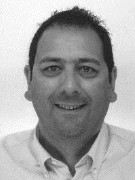 Cyril Luxey (M’05-SM’09- F’17) received the Ph.D. degree in electrical engineering (1999) from the University Nice-Sophia Antipolis, France. Since 2009, he is a Full Professor at the IUT Réseaux et Télécoms in Sophia-Antipolis. He is doing his research in the Polytech’Lab. In October 2010, he has been appointed as a Junior Member of the Institut Universitaire de France (IUF) institution for five years. His current research interests include the design and measurement of Millimeter-wave antennas, antennas-in-package, plastic lenses and organic modules for mm-wave and sub-mm wave frequency bands. He also works on electrically small antennas, multi-antenna systems for diversity and MIMO techniques. Cyril Luxey and his students received the H.W. Wheeler Award of the IEEE Antennas and Propagation Society for the best application paper of the year 2006. He is also the co-recipient of the Jack Kilby Award 2013 of the ISSCC conference. Cyril Luxey has authored or co-authored more than 300 papers in refereed journals, in international and national conferences and as book chapters. He has been the general chair of the Loughborough Antennas and Propagation Conference 2011, the award and grant chair of EuCAP 2012 and the invited paper co-chair of EuCAP 2013 and the TPC chair of EuCAP 2017 conference in Paris.
Cyril Luxey (M’05-SM’09- F’17) received the Ph.D. degree in electrical engineering (1999) from the University Nice-Sophia Antipolis, France. Since 2009, he is a Full Professor at the IUT Réseaux et Télécoms in Sophia-Antipolis. He is doing his research in the Polytech’Lab. In October 2010, he has been appointed as a Junior Member of the Institut Universitaire de France (IUF) institution for five years. His current research interests include the design and measurement of Millimeter-wave antennas, antennas-in-package, plastic lenses and organic modules for mm-wave and sub-mm wave frequency bands. He also works on electrically small antennas, multi-antenna systems for diversity and MIMO techniques. Cyril Luxey and his students received the H.W. Wheeler Award of the IEEE Antennas and Propagation Society for the best application paper of the year 2006. He is also the co-recipient of the Jack Kilby Award 2013 of the ISSCC conference. Cyril Luxey has authored or co-authored more than 300 papers in refereed journals, in international and national conferences and as book chapters. He has been the general chair of the Loughborough Antennas and Propagation Conference 2011, the award and grant chair of EuCAP 2012 and the invited paper co-chair of EuCAP 2013 and the TPC chair of EuCAP 2017 conference in Paris.
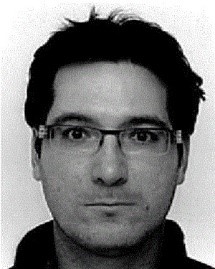 Frédéric Gianesello (M’13) received the B.S. and M.S. degrees in electronics engineering from the Institut National Polytechnique de Grenoble, Grenoble, France, in 2003 and the Ph.D. degree in electrical engineering from the Joseph Fourier University, Grenoble, France, in 2006. He is currently working for STMicroelecetronics, Crolles, France, where he leads the team responsible for the development of electromagnetic devices (inductor, balun, transmission line, and antenna) integrated on advanced RF CMOS/BiMOS (down to 14 nm), silicon photonics, and advanced packaging technologies (3-D Integration, FOWLP, etc.). He has authored and coauthored more than 110 refereed journal and conference technical articles. Dr. Gianesello has served on the TPC for the International SOI Conference from 2009 up to 2011 and he is currently serving on the TPC for the Loughborough Antennas and Propagation Conference (LAPC).
Frédéric Gianesello (M’13) received the B.S. and M.S. degrees in electronics engineering from the Institut National Polytechnique de Grenoble, Grenoble, France, in 2003 and the Ph.D. degree in electrical engineering from the Joseph Fourier University, Grenoble, France, in 2006. He is currently working for STMicroelecetronics, Crolles, France, where he leads the team responsible for the development of electromagnetic devices (inductor, balun, transmission line, and antenna) integrated on advanced RF CMOS/BiMOS (down to 14 nm), silicon photonics, and advanced packaging technologies (3-D Integration, FOWLP, etc.). He has authored and coauthored more than 110 refereed journal and conference technical articles. Dr. Gianesello has served on the TPC for the International SOI Conference from 2009 up to 2011 and he is currently serving on the TPC for the Loughborough Antennas and Propagation Conference (LAPC).
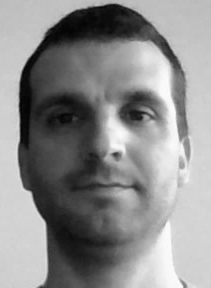 Sérgio A. Matos (S’05–M’16) received the Licenciado, M.Sc., and Ph.D. degrees in electrical and computer engineering from Instituto Superior Técnico (IST), University of Lisbon, Lisbon, Portugal, in 2004, 2005, and 2010, respectively. He is currently a Researcher with the Instituto de Telecomunicações (IT), Lisbon, Portugal. He is also an Assistant Professor at the Departamento de Ciências e Tecnologias da Informação, Instituto Universitário de Lisboa (ISCTE-IUL). He is the co-author of 60 technical papers in international journals and conference proceedings. His present research interests include electromagnetic wave propagation in metamaterials, flat-lens design and transmit arrays.
Sérgio A. Matos (S’05–M’16) received the Licenciado, M.Sc., and Ph.D. degrees in electrical and computer engineering from Instituto Superior Técnico (IST), University of Lisbon, Lisbon, Portugal, in 2004, 2005, and 2010, respectively. He is currently a Researcher with the Instituto de Telecomunicações (IT), Lisbon, Portugal. He is also an Assistant Professor at the Departamento de Ciências e Tecnologias da Informação, Instituto Universitário de Lisboa (ISCTE-IUL). He is the co-author of 60 technical papers in international journals and conference proceedings. His present research interests include electromagnetic wave propagation in metamaterials, flat-lens design and transmit arrays.
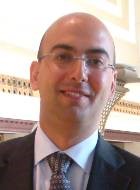 Jorge R. Costa (S’97–M’03–SM’09) was born in Lisbon, Portugal, in 1974. He received the Licenciado and Ph.D. degrees in electrical and computer engineering from the Instituto Superior Técnico (IST), Technical University of Lisbon, Lisbon, Portugal, in 1997 and 2002, respectively. He is currently a Senior Researcher at the Instituto de Telecomunicações, Lisbon, Portugal. He is also an Associate Professor at the Departamento de Ciências e Tecnologias da Informação, Instituto Universitário de Lisboa (ISCTE-IUL). His present research interests include lenses, reconfigurable antennas, MEMS switches, UWB, MIMO and RFID antennas. He is the coauthor of four patent applications and more than 150 contributions to peer reviewed journals and international conference proceedings. More than thirty of these papers have appeared in IEEE Journals. Prof. Costa served as an Associate Editor for the IEEE Transactions on Antennas and Propagation from 2010 to 2016 and he was a Guest Editor of the Special Issue on “Antennas and Propagation at mm- and Sub mm-Waves”, from the IEEE Transactions on Antennas and Propagation, April 2013. He was the Co-Chair of the Technical Program Committee of the European Conference on Antennas and Propagation (EuCAP 2015) in Lisbon and General Vice-Chair of EuCAP 2017 in Paris.
Jorge R. Costa (S’97–M’03–SM’09) was born in Lisbon, Portugal, in 1974. He received the Licenciado and Ph.D. degrees in electrical and computer engineering from the Instituto Superior Técnico (IST), Technical University of Lisbon, Lisbon, Portugal, in 1997 and 2002, respectively. He is currently a Senior Researcher at the Instituto de Telecomunicações, Lisbon, Portugal. He is also an Associate Professor at the Departamento de Ciências e Tecnologias da Informação, Instituto Universitário de Lisboa (ISCTE-IUL). His present research interests include lenses, reconfigurable antennas, MEMS switches, UWB, MIMO and RFID antennas. He is the coauthor of four patent applications and more than 150 contributions to peer reviewed journals and international conference proceedings. More than thirty of these papers have appeared in IEEE Journals. Prof. Costa served as an Associate Editor for the IEEE Transactions on Antennas and Propagation from 2010 to 2016 and he was a Guest Editor of the Special Issue on “Antennas and Propagation at mm- and Sub mm-Waves”, from the IEEE Transactions on Antennas and Propagation, April 2013. He was the Co-Chair of the Technical Program Committee of the European Conference on Antennas and Propagation (EuCAP 2015) in Lisbon and General Vice-Chair of EuCAP 2017 in Paris.
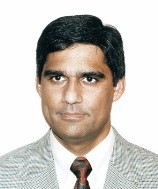 Carlos A. Fernandes (S’86–M’89–SM’08) received the Licenciado, MSc, and PhD degrees in Electrical and Computer Engineering from Instituto Superior Técnico (IST), Technical University of Lisbon, Lisbon, Portugal, in 1980, 1985, and 1990, respectively. He joined IST in 1980, where he is presently Full Professor at the Department of Electrical and Computer Engineering in the areas of microwaves, radio wave propagation and antennas. He is a senior researcher at the Instituto de Telecomunicações and member of the Board of Directors. He has co-authored a book, 2 book chapter, more than 180 technical papers in peer reviewed international journals and conference proceedings and 7 patents in the areas of antennas and radiowave propagation modeling. His current research interests include dielectric antennas for millimeter wave applications, antennas and propagation modeling for personal communication systems, RFID and UWB antennas, artificial dielectrics and metamaterials. He was a Guest Editor of the Special Issue on “Antennas and Propagation at mm-and Submm-Waves”, from the IEEE Trans. on Antennas & Propagation, April 2013.
Carlos A. Fernandes (S’86–M’89–SM’08) received the Licenciado, MSc, and PhD degrees in Electrical and Computer Engineering from Instituto Superior Técnico (IST), Technical University of Lisbon, Lisbon, Portugal, in 1980, 1985, and 1990, respectively. He joined IST in 1980, where he is presently Full Professor at the Department of Electrical and Computer Engineering in the areas of microwaves, radio wave propagation and antennas. He is a senior researcher at the Instituto de Telecomunicações and member of the Board of Directors. He has co-authored a book, 2 book chapter, more than 180 technical papers in peer reviewed international journals and conference proceedings and 7 patents in the areas of antennas and radiowave propagation modeling. His current research interests include dielectric antennas for millimeter wave applications, antennas and propagation modeling for personal communication systems, RFID and UWB antennas, artificial dielectrics and metamaterials. He was a Guest Editor of the Special Issue on “Antennas and Propagation at mm-and Submm-Waves”, from the IEEE Trans. on Antennas & Propagation, April 2013.
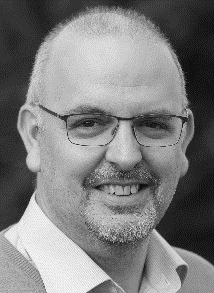 Carlos del Río Bocio (M’93, SM’14) Since 1993, he develops his research and docent activities in the Public University of Navarra in the Electric and Electronic Engineering department. Nowadays he is associate professor in the Electronic and Electronic Engineering Department of the Public University of Navarra and is working in the Antenna Research Group. His expertise covers horn antenna design in general, satellite and terrestrial communications, study of periodic structures, Coherently Radiating Periodic Structures (CORPS), cooperative beam forming networks, meta-materials applied to antenna applications, hyperacuity, inverse problem copying the human eye, image processing, numerical computation software based on mode matching and scattering matrix, antenna measurements, far-and near field measurement chambers, compact ranges, etc. He has authored more than 120 papers published on international journals and conferences. Nowadays, he is the director of the Institute of Smart Cities of the Public University of Navarra.
Carlos del Río Bocio (M’93, SM’14) Since 1993, he develops his research and docent activities in the Public University of Navarra in the Electric and Electronic Engineering department. Nowadays he is associate professor in the Electronic and Electronic Engineering Department of the Public University of Navarra and is working in the Antenna Research Group. His expertise covers horn antenna design in general, satellite and terrestrial communications, study of periodic structures, Coherently Radiating Periodic Structures (CORPS), cooperative beam forming networks, meta-materials applied to antenna applications, hyperacuity, inverse problem copying the human eye, image processing, numerical computation software based on mode matching and scattering matrix, antenna measurements, far-and near field measurement chambers, compact ranges, etc. He has authored more than 120 papers published on international journals and conferences. Nowadays, he is the director of the Institute of Smart Cities of the Public University of Navarra.
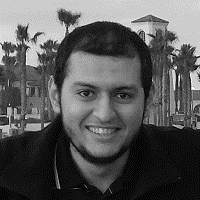 Mahmoud Sawaby (S’14) received the M.Sc. degree from Cairo University, Giza, Egypt, in 2014, where he focused on a millimeter-wave imaging system for skin and breast tumor detection. He is currently pursuing the Ph.D. degree in electrical engineering with Stanford University, Stanford, CA, USA. In 2011 and 2014, he was a part-time Analog Design Engineer with Si-ware systems, where he designed front-ends for bridge interfaces, thermal control loops, and cap-less ADC reference buffers. His current research interests include mm-Wave systems for high-speed wireless links, and low-power IC designs. Mr. Sawaby was a recipient of the TGD Best Graduation Project Award in 2011, and the Fairchild Most Unusual Design Award in 2014. In 2016, he won “John von Neumann Student Research Award for Excellence in Architectures Research” from SONIC and “Outstanding Student Designer” from ADI.
Mahmoud Sawaby (S’14) received the M.Sc. degree from Cairo University, Giza, Egypt, in 2014, where he focused on a millimeter-wave imaging system for skin and breast tumor detection. He is currently pursuing the Ph.D. degree in electrical engineering with Stanford University, Stanford, CA, USA. In 2011 and 2014, he was a part-time Analog Design Engineer with Si-ware systems, where he designed front-ends for bridge interfaces, thermal control loops, and cap-less ADC reference buffers. His current research interests include mm-Wave systems for high-speed wireless links, and low-power IC designs. Mr. Sawaby was a recipient of the TGD Best Graduation Project Award in 2011, and the Fairchild Most Unusual Design Award in 2014. In 2016, he won “John von Neumann Student Research Award for Excellence in Architectures Research” from SONIC and “Outstanding Student Designer” from ADI.
 Amin Arbabian (S’06–M’12–SM’17) received the Ph.D. degree in electrical engineering and computer science from the University of California at Berkeley (UC Berkeley), Berkeley, CA, USA, in 2011. From 2007 and to 2008, he was part of the Initial Engineering Team, Tagarray, Inc., Palo Alto, CA, USA. He was with the Qualcomm’s Corporate Research and Development Division, San Diego, CA, USA, in 2010, where he designed circuits for next generation ultra low power wireless transceivers. In 2012, he joined Stanford University, Stanford, CA, USA, as an Assistant Professor of electrical engineering, where he is currently a Frederick E. Terman Fellow with the School of Engineering. His current research interests include high-frequency systems, medical imaging, Internet-of-Everything devices including wireless power delivery techniques, and medical implants. Dr. Arbabian was the recipient or corecipient of the 2016 Stanford University Tau Beta Pi Award for Excellence in Undergraduate Teaching, the 2015 NSF CAREER Award, the 2014 DARPA Young Faculty Award including the Director’s Fellowship in 2016, the 2013 Hellman Faculty Scholarship, the 2010–2011, 2014–2015, and 2016–2017 Qualcomm Innovation fellowships, and best paper awards at the 2017 IEEE Biomedical Circuits and Systems Conference, the 2016 IEEE Conference on Biomedical Wireless Technologies, Networks, and Sensing Systems, the 2014 IEEE VLSI Circuits symposium, the 2013 IEEE International Conference on Ultra-Wideband, the 2010 IEEE Jack Kilby Award for Outstanding Student Paper at the International Solid-State Circuits Conference, and two time second place best student paper awards at 2008 and 2011 RFIC symposiums. He currently serves on the steering committee of RFIC Symposium, the technical program committees of RFIC symposium, ESSCIRC, and VLSI Circuits Symposium, and as an Associate Editor of the IEEE SOLID-STATE CIRCUITS LETTERS and the IEEE JOURNAL OF ELECTROMAGNETICS, RF AND MICROWAVES IN MEDICINE AND BIOLOGY.
Amin Arbabian (S’06–M’12–SM’17) received the Ph.D. degree in electrical engineering and computer science from the University of California at Berkeley (UC Berkeley), Berkeley, CA, USA, in 2011. From 2007 and to 2008, he was part of the Initial Engineering Team, Tagarray, Inc., Palo Alto, CA, USA. He was with the Qualcomm’s Corporate Research and Development Division, San Diego, CA, USA, in 2010, where he designed circuits for next generation ultra low power wireless transceivers. In 2012, he joined Stanford University, Stanford, CA, USA, as an Assistant Professor of electrical engineering, where he is currently a Frederick E. Terman Fellow with the School of Engineering. His current research interests include high-frequency systems, medical imaging, Internet-of-Everything devices including wireless power delivery techniques, and medical implants. Dr. Arbabian was the recipient or corecipient of the 2016 Stanford University Tau Beta Pi Award for Excellence in Undergraduate Teaching, the 2015 NSF CAREER Award, the 2014 DARPA Young Faculty Award including the Director’s Fellowship in 2016, the 2013 Hellman Faculty Scholarship, the 2010–2011, 2014–2015, and 2016–2017 Qualcomm Innovation fellowships, and best paper awards at the 2017 IEEE Biomedical Circuits and Systems Conference, the 2016 IEEE Conference on Biomedical Wireless Technologies, Networks, and Sensing Systems, the 2014 IEEE VLSI Circuits symposium, the 2013 IEEE International Conference on Ultra-Wideband, the 2010 IEEE Jack Kilby Award for Outstanding Student Paper at the International Solid-State Circuits Conference, and two time second place best student paper awards at 2008 and 2011 RFIC symposiums. He currently serves on the steering committee of RFIC Symposium, the technical program committees of RFIC symposium, ESSCIRC, and VLSI Circuits Symposium, and as an Associate Editor of the IEEE SOLID-STATE CIRCUITS LETTERS and the IEEE JOURNAL OF ELECTROMAGNETICS, RF AND MICROWAVES IN MEDICINE AND BIOLOGY.
Editor: Rod Waterhouse
Subscribe to Tech Focus
Join our IEEE Future Networks Technical Community and receive IEEE Future NetworksTech Focus delivered to your email.
Article Contributions Welcome
Submit Manuscript via Track Chair
Author guidelines can be found here.
Other Future Networks Publications
IEEE Future Networks Tech Focus Editorial Board
Rod Waterhouse, Editor-in-Chief
Mithun Mukherjee, Managing Editor
Imran Shafique Ansari
Anwer Al-Dulaimi
Stefano Buzzi
Yunlong Cai
Zhi Ning Chen
Panagiotis Demestichas
Ashutosh Dutta
Yang Hao
Gerry Hayes
Chih-Lin I
James Irvine
Meng Lu
Amine Maaref
Thas Nirmalathas
Sen Wang
Shugong Xu
Haijun Zhang
Glaucio Haroldo Silva de Carvalho

